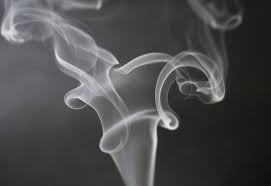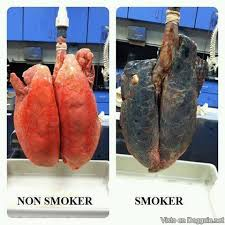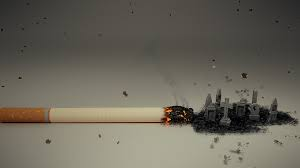
Greetings friends Steemianos, we know that the act of smoking is a practice where a substance (commonly tobacco, but it can also be opium or marijuana, among others) is burned and then tested or inhaled its smoke, mainly because through combustion is released active substances (such as nicotine), which are absorbed by the body through the lungs.
The act of smoking can be part of different rituals, induce some trance or achieve a "spiritual illumination", depending on the type of drug.
But where did this act of smoking come from?
It can be traced back to the 2nd century BC, approximately, and is registered in different cultures around the world. The smoking of tobacco, at first was exclusive of the American continent. After the conquest of America by Europeans, the practice of smoking tobacco (it is considered a legal drug even if it is harmful to health), and this spread rapidly throughout the rest of the world. In regions such as India and sub-Saharan Africa it was mixed with existing practices (mainly smoking marijuana) and in Europe marked the beginning of a new social activity unknown until then.
Methods for smoking
The most common smoking method today is through cigarettes, mainly those manufactured industrially, although they are also available in a hand-rolled format (rolling tobacco). Other ways of smoking, though not as common, are through pipes and bongs.
With tobacco we face a triple dependency.

On the one hand, there is the physical dependence of nicotine, which is what hooks people: when smoking this substance causes a series of effects in the brain and produces relaxation and pleasure, among others; By lowering the level of nicotine the body asks for more.

Secondly, we have a psychological dependence, why? ... We associate having a coffee with smoking, concentrating with lighting a cigarette, talking on the phone while giving some aspirations, etc. All this creates a psychological dependence.

Lastly, we have social dependency. Tobacco means smoking within a social norm. And in that context the family plays an important role.
Third-hand smoke or passive smoking.

It is the smoke of the tobacco that remains in the places where it has been smoked. This leaves nicotine particles that are deposited on carpets, furniture, clothes and other surfaces. The problem is that these microparticles react with ozone and is just as harmful as environmental smoke and these particles can stay for hours on surfaces allowing entry into the lungs even if no one is smoking.
Tobacco smoke in the environment causes illness and premature death in adults who do not smoke and in children, in fact, exposure to second-hand smoke irritates the respiratory tract and has immediate harmful effects on the person's heart and Blood vesels.
- Increases the risk of heart disease by 25 to 30%.
- Increases the risk of stroke by 20 to 30%.
- And pregnant women exposed to tobacco smoke in the environment are at risk of having a baby with a little decrease in their birth weight.
What harmful chemicals does tobacco smoke contain?
Tobacco smoke contains many chemicals that are harmful to both smokers and non-smokers. Breathing only a little bit of tobacco smoke can be harmful.
Of the more than 7000 chemicals present in tobacco smoke, at least 250 are known to be harmful, including hydrogen cyanide, carbon monoxide and ammonia.
Of the 250 substances known to be harmful in tobacco smoke, at least 69 can cause cancer.
These carcinogenic chemicals are the following:
• Acetaldehyde
• Aromatic amines
• Arsenic
• Benzene
• Beryllium (a toxic metal)
• 1,3-butadiene (a dangerous gas)
• Cadmium (a toxic metal)
• Vinyl chloride
• Chrome (a metallic element)
• Cumeno
• Formaldehyde
• Polycyclic aromatic hydrocarbons (PAH)
• Nickel (a metallic element)
• Tobacco-specific Nitrosamine
• Ethylene oxide
• Polonium-210 (a radioactive chemical element)

I leave a video shared by a US doctor of the organ affected by tobacco use
videoDoes smoking addictive?
Smoking is highly addictive. Nicotine is the drug responsible in the first place for a person's addiction to tobacco products, including cigarettes. The addiction to cigarettes and other tobacco products caused by nicotine is similar to the addiction produced by the use of drugs such as heroin and cocaine.
Nicotine is naturally present in the tobacco plant. But tobacco companies intentionally design cigarettes so they have enough nicotine to create and maintain addiction.
The amount of nicotine that enters the body is determined by how a person smokes a tobacco product and by the nicotine content and design of the product. Nicotine is absorbed into the bloodstream by the lining of the mouth and lungs and travels to the brain in a matter of seconds. The greatest amount of nicotine is absorbed by the body when inhaling tobacco smoke and taking frequent and deep puffs.

Are other tobacco products, such as smokeless tobacco or pipe tobacco, harmful and addictive?
Yes. All forms of tobacco are harmful and addictive. There is no tobacco product that is not harmful.
In addition to cigarettes, other forms of tobacco are smokeless tobacco, cigars, pipes, hookahs (water pipes), bidis and kreteks.
Smokeless tobacco: Smokeless tobacco is a type of tobacco that does not burn. It includes chewing tobacco, tobacco for the mouth, tobacco for spitting, spreading, chewing, dissolving and snuff. Smokeless tobacco causes oral cancers (mouth, tongue, cheek and gums), esophagus and pancreas and can also cause gum and heart disease.
Cigars: These include cigars, cigars with filter and cigarillos. Pure filter cigarettes look like cigarettes, but both pure filter cigarettes and cigarettes can have additional flavors to increase attractiveness for youth and adults. Most cigars are composed mainly of a single type of tobacco (air-cured and fermented), and have a tobacco leaf wrapper. Studies have found that cigar smoke contains higher levels of toxic chemicals than cigarette smoke, although unlike cigarette smoke, cigar smoke is often not inhaled. Smoking cigars causes cancer of the oral cavity, larynx, esophagus and lung. It can also cause pancreatic cancer. In addition, those who smoke cigars every day, particularly those who inhale, have a higher risk of heart disease and other types of lung disease.
Pipes: When smoking a pipe, the tobacco is placed in a concavity that is connected to a barrel with a nozzle at the other end. Ordinary smoke is not inhaled. Smoking pipe causes lung cancer and increases the risk of cancers of the mouth, throat, larynx and esophagus.
**Narguiles or water pipes (they are also called arguiles, hookahs, smoke bubbles, shishas, boorys and enjoyments): **The hookah is a device used to smoke tobacco (often with a rather strong flavor) when passing smoke through a saucepan partially filled with water before being inhaled by the smoker. Although some people believe that smoking with a hookah is less harmful and addictive than smoking cigarettes, research indicates that hookah smoke is at least as toxic as cigarette smoke.
Bidis: The bidi is a flavor cigarette that is prepared by wrapping tobacco in a dry leaf of the tendu tree, which grows in India. The use of bidis has been associated with heart attack and with cancers of the mouth, throat, larynx, esophagus and lung.
Kreteks: A kretek is a cigarette that is prepared by mixing tobacco with clove. Smoking kreteks is associated with lung cancer and other lung diseases.
What are the immediate health benefits of quitting?
The immediate health benefits of quitting smoking are important:
• The heart rate and blood pressure, which are abnormally high when smoked, begin to return to normal levels.
• After a few hours, the concentration of carbon monoxide in the blood begins to decrease. (Carbon monoxide reduces the ability of blood to carry oxygen).
• After a few weeks, people who stop smoking have better circulation, produce less phlegm and do not cough or have episodes of wheezing as often.
• After several months of quitting smoking, considerable improvement in lung function can be expected.
• Within a few years of quitting, you will have less risk of cancer, heart disease and other chronic diseases than if you continued smoking.
In conclusion friend Steemiano the decision is yours, if you smoke or not ... and those who do not like smoking support with an Upvote
Spanish version

I hope this article has been very helpful, and the images were courtesies of Pixabay.com CC0 license

The Roman Family is a community of writers, musicians, craftsmen, technicians, etc; dedicated to providing quality content in Steemit. We value the hard work of all those who live on this important platform.
To join our Discord server: Familia Romana
Here
If you consider this content useful please give ReSteem so that other people can get this information
Our witness is @guiltyparties who actively works to defend all steemians from phishing and abuse, is a member of steemcleaners and one of the witnesses that usually interacts with users, helping them with pleasure. This is why the Roman Family supports him. Vote @guiltyparties

.png)
